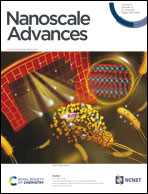The interaction of size-selected Ru3 clusters with RF-deposited TiO2: probing Ru–CO binding sites with CO-temperature programmed desorption†
Abstract
Small Ru clusters are efficient catalysts for chemical reactions such as CO hydrogenation. In this study 3-atom Ru3 clusters were deposited onto radio frequency (RF)-deposited TiO2 which is an inexpensive, nanoparticulate form of TiO2. TiO2 substrates are notable in that they form strong metal–substrate interactions with clusters. Using temperature programmed desorption to probe Ru–CO binding sites, and X-ray photoelectron spectroscopy to provide chemical information on clusters, differences in cluster–support interactions were studied for Ru3 deposited using both an ultra-high vacuum cluster source and chemical vapour deposition of Ru3(CO)12. The TiO2 was treated with different Ar+ sputter doses prior to cluster depositions, and SiO2 was also used as a comparison substrate. For cluster source-deposited Ru3, heating to 800 K caused cluster agglomeration on SiO2 and oxidation on non-sputtered TiO2. For cluster source-deposited Ru3 on sputtered TiO2 substrates, all Ru–CO binding sites were blocked as-deposited and it was concluded that for the binding sites to be preserved for potential catalytic benefit, sputtering of TiO2 before cluster deposition cannot be applied. Conversely, for Ru3(CO)12 on sputtered TiO2 the clusters were protected by their ligands and Ru–CO binding sites were only blocked once the sample was heated to 723 K. The mechanism for complete blocking of CO sites on sputtered TiO2 could not be directly determined; however, comparisons to the literature indicate that the likely reasons for blocking of the CO adsorption sites are encapsulation into the TiOx layer reduced through sputtering and also partial oxidation of the Ru clusters.



 Please wait while we load your content...
Please wait while we load your content...